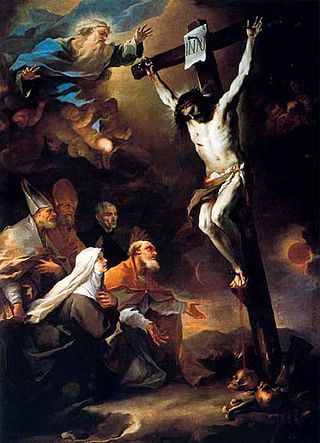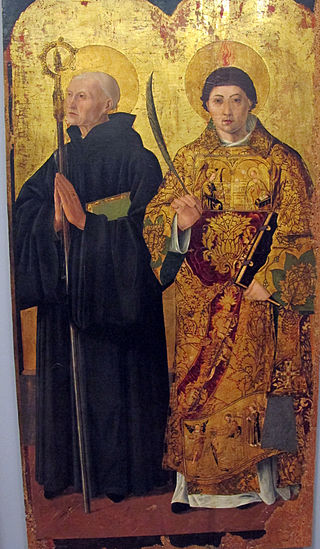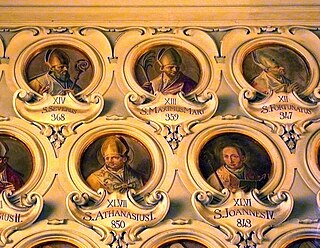
Pope Callixtus I, also called Callistus I, was the bishop of Rome from c. 218 to his death c. 222 or 223. He lived during the reigns of the Roman emperors Elagabalus and Alexander Severus. Eusebius and the Liberian catalogue list his episcopate as having lasted five years (217–222). In 217, when Callixtus followed Zephyrinus as Bishop of Rome, he started to admit into the Church converts from sects or schisms. He was martyred for his Christian faith and is venerated as a saint by the Catholic Church.

Januarius, also known as Januarius I of Benevento, was Bishop of Benevento and is a martyr and saint of the Catholic Church and the Eastern Orthodox Church. While no contemporary sources on his life are preserved, later sources and legends claim that he died during the Great Persecution, which ended with Diocletian's retirement in 305.

Nabor and Felix were Christian martyrs thought to have been killed during the Great Persecution under the Roman emperor Diocletian. A tomb in Milan is believed to contain their relics.
Saint Proculus (Proclus) of Pozzuoli was martyred around 305 AD, according to Christian tradition, at the same time as Saint Januarius.

San Gennaro dei Poveri is a former monastery and church complex, later converted into a hospital for indigent located on Via San Gennaro dei Poveri #25 in the Rione Sanità, of the city of Naples, Italy. The elongated complex rises towards Capodimonte, lying just south of the domed Basilica dell'Incoronata Madre del Buon Consiglio.

Felicitas of Rome, also anglicized as Felicity, is a saint numbered among the Christian martyrs. Apart from her name, the only thing known for certain about this martyr is that she was buried in the Cemetery of Maximus, on the Via Salaria on a 23 November. However, a legend presents her as the mother of the seven martyrs whose feast is celebrated on 10 July. The Eastern Orthodox Church celebrates their martyrdom on 25 January.

The Catacombs of San Gennaro are underground paleo-Christian burial and worship sites in Naples, Italy, carved out of tuff, a porous stone. They are situated in the northern part of the city, on the slope leading up to Capodimonte, consisting of two levels, San Gennaro Superiore, and San Gennaro Inferiore. The catacombs lie under the Rione Sanità neighborhood of Naples, sometimes called the "Valley of the Dead". The site is now easily identified by the large church of Madre del Buon Consiglio.
Saint Agrippinus (Arpinus) of Naples was a bishop of Naples and is venerated in that city as a saint. According to tradition, Agrippinus was the sixth bishop of Naples. He lived at the end of the 3rd century, and seems not to have been a martyr.

Severus of Barcelona is venerated as a saint by the Catholic and Eastern Orthodox churches. His legend states that he was a bishop of Barcelona and was martyred during the persecution of Christians by Diocletian in AD 304. Details concerning his life and death are uncertain and of questionable historicity.

Aspren or Asprenas was a 1st-century Christian saint and venerated as the first Bishop of Naples.
Gaudiosus of Naples or Gaudiosus the African was a bishop of Abitina, a village near Carthage in present-day western Tunisia, in the Roman Africa Province.

Saint Sossius or Sosius was Deacon of Misenum, an important naval base of the Roman Empire in the Bay of Naples. He was martyred along with Saint Januarius at Pozzuoli during the Diocletian Persecutions. His feast day is September 23, the date, three days after his death, on which his corpse was translated to Misenum.

The city of Naples has more than 50 official patron saints, although its principal patron is Saint Januarius. Second in terms of importance is Saint Aspren (Sant'Aspreno), first bishop of Naples.

Christianity and religion in general has always been an important part of the social and cultural life of Naples. It is the seat of the Archdiocese of Naples, and the Catholic faith is highly important to the people of Naples and there are hundreds of historic churches in the city. The Cathedral of Naples is the most important place of worship in the city, each year on September 19 it hosts the Miracle of Saint Januarius, the city's patron saint. In the miracle which thousands of Neapolitans flock to witness, the dried blood of Januarius is said to turn to liquid when brought close to relics said to be of his body: this is one of the most important traditions for Neapolitans.

The Museo del Tesoro di San Gennaro is a museum of religious relics in Naples, in Campania in southern Italy.

San Giorgio Maggiore is a basilica church located on the corner of Via vicaria Vecchia and Via Duomo, in central Naples, Italy. The apse of the church lies diagonally across the street from San Severo al Pendino.

The Catacombs of Saint Gaudiosus are underground paleo-Christian burial sites, located in the northern area of the city of Naples.

The Catacombs of San Sebastiano are a hypogeum cemetery in Rome, Italy, rising along Via Appia Antica, in the Ardeatino Quarter. It is one of the very few Christian burial places that has always been accessible. The first of the former four floors is now almost completely destroyed.

Fortunatus of Naples was a 4th-century Christian bishop. He is the first historically-attested bishop of Naples, as one of the recipients of a letter written by those who took part in the Arian Council of Philippopolis in the 340s - his tradition states he was a fierce opponent of Arianism. His term as bishop is traditionally held to be 347 to 359.

Saint Januarius Emerges Unscathed from the Furnace is an oil on copper painting by Jusepe de Ribera, commissioned in 1643 and completed three years later, in 1646. It is now in the Royal Chapel of the Treasure of St. Januarius in Naples Cathedral. It shows a legend relating to Naples' patron saint Januarius, shown as a bishop.
















